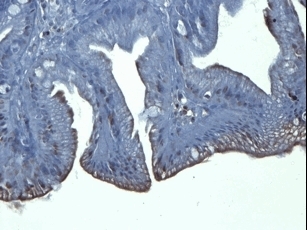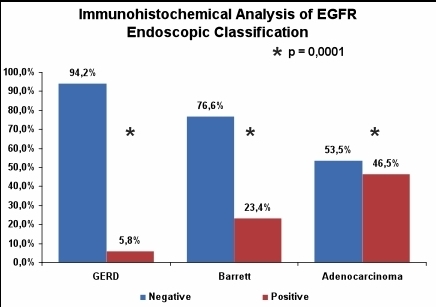
|
 |
Back to Annual Meeting Program
EGFR in Gastroesophageal Reflux Disease, Barrett's Esophagus, and Esophageal Adenocarcinoma
Guilherme Pretto*1,2, Richard R. Gurski1,2, Daniel Navarini1, Marcelo Binato1, Luise Meurer2, Laura Z. Costamilan2, Guilherme D. Mazzini2, Gabriela G. Costa1
1Programa de Pós-Graduação em Cirurgia, Universidade Federal do Rio Grande do Sul, Porto Alegre, Brazil; 2Digestive Surgery, Hospital de Clínicas de Porto Alegre, Porto Alegre, Brazil
Introduction: Gastroesophageal reflux disease (GERD) is a common pathology with a wide range clinical and endoscopic manifestations whose underlying mechanisms are not well understood. Epidermal growth factor receptor (EGFR), found in the epithelium of the digestive tract, plays an important role in epithelial repair and shows increased expression in a number of different neoplasms, including esophageal tumors.
Objectives: To evaluate EGFR expression using immunohistochemistry in esophageal biopsies obtained from patients with GERD, Barrett’s esophagus, and adenocarcinoma of the esophagus.
Methods: EGFR expression was immunohistochemically determined in biopsies from 194 patients with symptoms suggestive of GERD or adenocarcinoma of the esophagus seen at two Brazilian university hospitals between January 2003 and December 2008. Based on histopathological analysis, patients were divided into three groups: GERD, Barrett’s esophagus and adenocarcinoma of the esophagus. EGFR expression was considered positive when staining was detected in the membrane.
Results: Mean age was 55.25 years (30-90). Patients with GERD (n = 127) accounted for 65.5% of the sample, compared with 12.4% (n = 24) of patients with Barrett’s esophagus and 22.2% (n = 43) of patients with esophageal adenocarcinoma. Immunohistochemical analysis was positive for EGFR in 19.1% of the patients (37/194), divided as follows: 8.7% (11/127) in the GERD group, 25% (6/24) in the Barrett’s esophagus group, and 46.5% (20/43) in the esophageal adenocarcinoma group. Statistical analysis revealed significant differences between the three groups (p = 0.0001).
Conclusions: GERD patients showed lower levels of EGFR expression than patients with Barrett’s esophagus or patients with adenocarcinoma of the esophagus, suggesting a direct relationship between EGFR expression and disease progression.
Keywords: EGFR, GERD, adenocarcinoma, esophagus, Barrett’s esophagus.

Esophageal biopsy from a patient with Barrett’s esophagus, positive for EGFR expression

Immunohistochemical expression of EGFR in the three groups assessed.
Back to Annual Meeting Program
|



